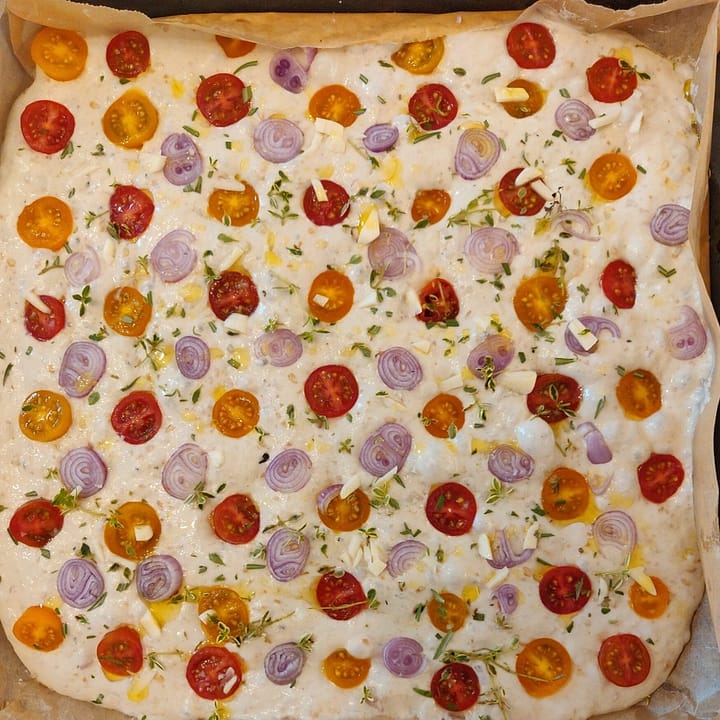Italian focaccia is appreciated for its soft texture, rich flavor, and crispiness. It is often compared to pizza due to its flat shape and topping of herbs and other ingredients, although focaccia is typically thicker than pizza and does not have tomato sauce. Don’t let the number of steps scare you away, it really is very simple to prepare.
Why we love italian focaccia
- Delicious Taste: Focaccia is made with simple ingredients like flour, olive oil, salt, and aromatic herbs, giving it a rich and delightful flavor. The addition of olive oil imparts a hint of richness and taste, while the herbs can vary according to preferences, providing a range of flavors.
- Soft Texture: Focaccia has a soft, slightly crispy exterior due to the olive oil, while the interior remains tender and soft, making it a pleasure to eat.
- Variety of Toppings: Focaccia can be topped with various ingredients such as olives, tomatoes, cheese, garlic, onions, herbs, and many more. This versatility allows everyone to customize their focaccia to their liking.
- Ease of Preparation: Focaccia is relatively simple to make at home, making it a comforting dish for many. It can also be found in many bakeries and restaurants, making it easily accessible.
- Versatile Accompaniment: Focaccia can be served as an appetizer, alongside a meal, or even as a main course with generous toppings. It pairs well with salads, soups, pasta dishes, or can simply be enjoyed with olive oil and herb dip.
- Italian Tradition: Focaccia originates from Italy, where it has been cherished for centuries. It is a part of Italy’s rich culinary tradition, adding a touch of romanticism for those who love Italian cuisine.
I discovered focaccia through a deliciousdays recipe and have been making it ever since. It’s a culinary delight that brings a taste of Italy to your kitchen!
The Secret of Slow Fermentation
Slow fermentation in the fridge, also known as cold fermentation, is a controlled fermentation technique that involves letting dough rest in a refrigerator for an extended period. This technique differs from traditional fermentation at room temperature, which occurs more quickly.
This method allows for the development of a richer flavor in the bread while providing better time management for dough preparation. It can also improve the digestibility of bread.
Steps of Cold Slow Fermentation
- Preparing the dough
- First Rise: the dough typically rests at room temperature for a short period to kickstart fermentation.
- Refrigeration: the dough is placed in a refrigerator. Fermentation continues at a much slower pace at lower temperatures. It allows enzymes present in the dough to break down complex compounds, giving the dough a richer and more complex flavor. This process can also help reduce the amount of phytic acid, which can make the dough more digestible.
- Shaping and Second Rise: After the cold fermentation period, the dough is usually taken out of the refrigerator, shaped into the desired form, and then left at room temperature for a shorter second rise. This step allows the dough to relax and adapt to its new shape.
- Baking: Finally, the shaped and risen dough is baked to perfection.
These steps in cold slow fermentation contribute to the unique flavor, texture, and digestibility of the bread, making it a favored technique among bread makers.

Focaccia - Overnight soft and crispy Italian bread without kneading
Ingredients
- 500 ml of warm water
- 2 teaspoons of dry yeast
- 2 teaspoons of fine sea salt
- 550 g of flour
- Extra virgin olive oil
- Toppings: coarse sea salt, rosemary, olives, or anything else you like
Instructions
- Preparing the dough: Dissolve the yeast in warm water. Add the yeast mixture to a large bowl with the flour and the salt. Stir for about 2 minutes. The dough should not be overworked; its consistency will remain quite soft and sticky.
- First Rise: Sprinkle one to two tablespoons of olive oil over the dough.
- Refrigeration: Keep the dough in the refrigerator overnight.
- Shaping and Second Rise: Gently pour the dough onto a greased baking sheet or pan and let it rest for 2 hours in a warm, draft-free place.
- Baking: Preheat the oven to 230°C. Sprinkle one to two tablespoons of olive oil, coarse sea salt, chopped herbs, and optionally olives or other toppings of your choice over the dough. Bake for approximately 15 to 20 minutes or until it is lightly golden on top.
- Enjoy your homemade focaccia!





[…] Focaccia – Overnight soft and crispy Italian bread without kneading […]